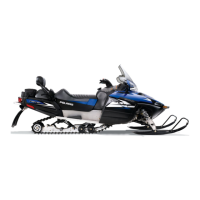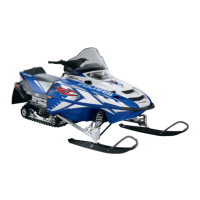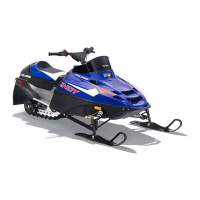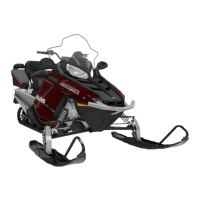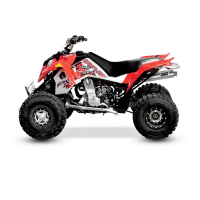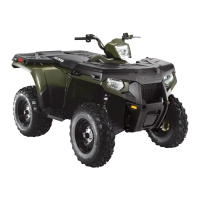8.38
Steering and Suspensions
rear torsion springs. Second, it prepares the rear portion of the
suspension for the bump, reducing secondary kick back.
The FRSS is made of a resilient material allowing smooth action
and preventing any suspension component damage.
The RRSS controls weight transfer from the rear suspension to
the skis. It also influences the stiffness of the ride by controlling
the amount of coupling action between the front and rear torque
arms. To decrease weight transfer, the RRSS should be set in the
high position.
The RRSS can be removed for maximum weight transfer.
However, unless the torsion springs and rear shock valving are
changed, the ride will be compromised. Always maintain equal
adjustment on both sides.
The dot is an indicator of the HIGH position. The sides are the
LOW position and the bottom is the MEDIUM position.
Limiter Strap Adjustment
One method of changing ski-to-snow pressure is to change the
length of the front limiter straps.
• Lengthening the straps decreases ski pressure under
acceleration.
• Shortening the straps increases ski pressure under
acceleration.
Set up Recommendations for Optimum Performance
(RMK / Switchback Rear Suspensions)
• DEEP POWDER SNOW: Limiter strap in LOW
position for maximum lift and flotation
• POWDER-HARDPACK: Limiter strap in STANDARD
position for overall handling and speed over snow.
• HARDPACK: Limiter strap in HIGH position for
increased control and less transfer.
Torsion Spring Adjustment
To adjust the rear torsion spring, rotate the adjuster cam to the
desired adjustment. The cam has three sides, LOW, MEDIUM
and HIGH.
HIGH
LOW
LOW
MEDIUM
Cam in LOW Position
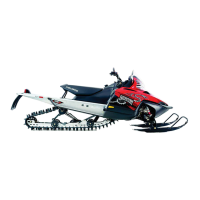
